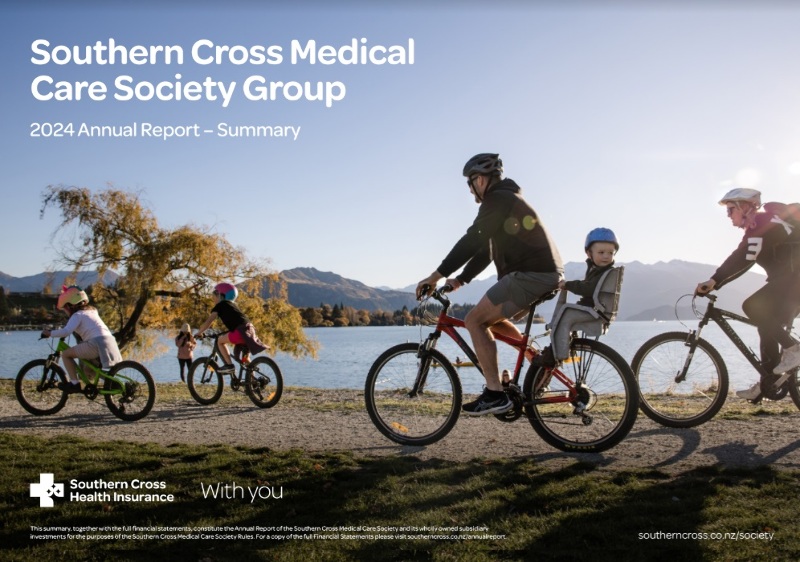
-
Pressure in public health system drives demand into private healthcare sector
-
More Southern Cross members claiming and claiming more frequently – claims costs increased 15% on FY23
-
Claims paid at rate of $6 million per business day up from $5.2 million in FY23
-
The Society Group reports a deficit of $88 million
-
Membership continues to grow – 15,196 net new members with a total membership of 955,301
-
Out of every dollar received in premiums, 93.4 cents were paid in claims, compared to an industry average (excluding Southern Cross) of 73 cents
Nick Astwick, Chief Executive for Southern Cross Health Society says more people are prioritising their healthcare which is driving more demand into the private healthcare sector.
“We have never been in more demand by our members as they prioritise their health needs, largely in the private system. In 2019 33% of our membership claimed, last year it was 50%,” he said.
“We’re also continuing to grow, welcoming more than 15,000 net new members to Society over the year taking us to 955,301 members, our highest membership since 1992.”
Astwick says the surge in claims has contributed to a Society Group deficit of $88 million. This follows a combined surplus of $73.6 million in the prior two financial years¹.
“Overall, the cost of claims increased 15% on the prior year, which compares to an increase of 9% in premiums. As a member driven, for purpose organisation, we made it a priority to keep premium increases as low as possible for members in this cost-of-living crisis. As a result, we anticipated a deficit in FY24.
“It’s this timing gap between claims cost inflation and our ability to apply premium increases that is the primary reason for the Health Insurance deficit,” he said.
Almost half of the deficit, ($43 million) is attributed to a change in international financial reporting standards² introduced in this financial year. Astwick says the balance of the deficit, $45 million, is driven by the higher claims cost from a persistently high inflationary environment combined with increased demand, and partially offset by investment returns.
“The cost of claims in 2024 was steep and rapid, driven by a combination of price, volume, and the mix of claims. The growth in the volume of claims results from an increase in the number of members claiming, the frequency, and claims being made for more expensive procedures,” he said.
Southern Cross Health Insurance paid $1.498 billion in claims from $1.605 billion received in premiums. The previous year the health insurance business paid out $1.302 billion in claims out of $1.466 billion received in premiums.
“More than 93% of premiums were returned to our membership in claims for their private healthcare this year,” adds Astwick.
“This is the highest return in more than ten years. Compared to the market return of 73%, this represents $326 million more paid to our members in the form of claims than the rest of New Zealand’s health insurance sector would have paid out³.
“This remains the Southern Cross difference.”
Astwick remarks that generating a small surplus in most years is essential to ensure the Society has sufficient capital reserves to remain financially sustainable into the future. Over the past five years, the Society has reported an average surplus of $13 million per year.
“Over our 63 years we have built a strong capital position to navigate times like this where we generate a deficit. We are committed to generating the surpluses required to maintain our A+ credit rating and to meet our capital adequacy needs.”
Like many households and businesses in Aotearoa New Zealand, Astwick says the Society has a significant cost control programme underway.
“Our operating costs grew by 4% in this financial year, slightly below the average inflation rate and we are planning to reduce our operating cost base in the next financial year.
“Alongside this is our more than 2,400 healthcare partners are keeping their cost increases as low as they practicably can, to support a united goal of keeping premium increases as low as possible for our members. To this end, our unique Affiliated Provider (AP) programme continues to provide savings for members. We are committed to evolving the AP programme to ensure more procedures are included.”
Astwick points to ways members can reduce premium costs.
“Throughout our shared cost-of-living crisis, we have focused on ensuring our members are aware of and can access ways to reduce the premiums they pay to ensure they retain their Health Insurance cover.
“Members can easily make changes to their cover to ensure affordability, such as adding an excess or changing their plan.”
In October this year, Southern Cross Health Insurance will introduce benefit improvements to nearly all of its policies in a major product review.
“While we are increasing benefits, we are also very mindful of costs to members and we’re using our contracting tools with APs accordingly. We’re also making it easier for our members to engage with Southern Cross – removing excess on some benefits, rewriting policy documents in plain language and making sure members are better informed about benefits, approved procedures and how to get the help they need,” said Astwick.
Astwick also points to the value derived from membership including liaising with the ACC on members’ behalf, and how almost 40,000 members have accessed unlimited standard virtual GP consultations with Care HQ with no cash outlay, 4,635 mental health consultations with Raise, and 4,016 annual check-ups with MedPro.
Regulation
Astwick says the Society is also working diligently to meet obligations under the Financial Markets (Conduct of Institutions) Amendment Act 2022 (CoFI).
“The introduction of CoFI has presented us with the opportunity to align our member-focused values and business practices with the regulatory expectation to treat our members fairly and to deliver fair outcomes.
Astwick is clear on the future focus for Southern Cross.
“We are committed to earning our position as our members trusted health insurer, providing assurance that access to healthcare is there when they need it. As a member driven organisation, we will continue to evolve our products and services to empower our members to live well for longer.”
Southern Cross Medical Care Society Chair Murray Jordan has announced he will retire from the Board at the AGM on 4 December this year. The Board has appointed current Society Director Chris Black to take on the Chair role, which will take effect at the close of the AGM.
For more information please see here.
Snapshot figures
Health Society Group Financial performance
Health Society Group incurred a $88.2 million deficit after tax
Southern Cross Health Insurance at a glance
955,301 members – net increase of 15,196
3.2 million claims in FY24, including:
High value procedures by total amount paid (GST inclusive):
Cost of common procedures funded by Southern Cross:
Adults
Children
¹Southern Cross Medical Care Society Group reported a deficit of $16.5 million in FY23 and a surplus of $90 million in FY22. The financial reporting for these periods was under the previous insurance contracts accounting standard (IFRS 4).
²IFRS17 is the newest International Financial Reporting Standard for insurance contracts.
³$326 million is the difference between the value of total claims paid by Southern Cross Health Insurance at its current 93% loss ratio and the value of total claims Society would have paid if it was paying out at the industry’s average (excluding Southern Cross) loss ratio of 73%. Based on data provided by the Financial Services Council and including an estimate for nib
⁴S&P Global is a trusted source of information for the international business community. Its “ratings analysis” assesses the potential direction of a long-term credit rating.
⁵Southern Cross makes up 60% of the health insurance market. Based on data provided by the Financial Services Council and including an estimate for nib
-
- Pressure in public health system drives demand into private healthcare sector
-
More Southern Cross members claiming and claiming more frequently – claims costs increased 15% on FY23
-
Claims paid at rate of $6 million per business day up from $5.2 million in FY23
-
The Society Group reports a deficit of $88 million
-
Membership continues to grow – 15,196 net new members with a total membership of 955,301
-
Out of every dollar received in premiums, 93.4 cents were paid in claims, compared to an industry average (excluding Southern Cross) of 73 cents
-
- Pressure in public health system drives demand into private healthcare sector
- More Southern Cross members claiming and claiming more frequently – claims costs increased 15% on FY23
- Claims paid at rate of $6 million per business day up from $5.2 million in FY23
- The Society Group reports a deficit of $88 million
- Membership continues to grow – 15,196 net new members with a total membership of 955,301
- Out of every dollar received in premiums, 93.4 cents were paid in claims, compared to an industry average (excluding Southern Cross) of 73 cents
- Southern Cross Health Insurance reported a deficit of $99.1 million
- The Society’s investments in its Pet Insurance and Travel Insurance businesses generated a combined net surplus after tax of $11.6 million
- Claims increased by 15% from the year before
- Southern Cross Health Insurance operating costs over the year increased by less than inflation at 4%
- 78% rise in number of telehealth consults delivered by CareHQ
- Health Society Group Reserves – $470.7m
- A+ Standard and Poor’s financial strength rating⁴
- Has 60% of the New Zealand health insurance market by customer numbers but 71% per cent of the value of all health insurance claims paid in Aotearoa New Zealand⁵.
- $1.498 billion in claims was paid out of $1.605 billion received in premiums, $6 million paid out in claims every business day
- Out of every dollar received in premiums, 93.3 cents were paid in claims, compared to an industry average (excluding Southern Cross) of 73.0 cents. That’s $326 million more paid to members than the industry average.
- 316,700 surgical procedures (up 8.0%)
- 609,523 specialist consultations (up 7.2%)
- 809,969 GP visits (up 12.4%)
- 213,248 prescriptions (down 65.6%)
- $70.7m knee replacement (up 17.1%)
- $70.2m colonoscopy (up 17.2%)
- $65.8m hip replacement (up 11.1%)
- $46.2m spinal fusion (up 11.4%)
- $44.9m skin excisions (up 13.7%)
- Skin cancer removal: $300 – $2,300
- Prostate cancer surgery: $24,800 – $31,100
- Knee replacement: $27,800 – $33,300
- Hip replacement: $26,600 – $32,600
- Varicose veins: $5,400 – $9,100
- Breast cancer surgery: $8,700 – $27,200
- Colonoscopy (with or without associated procedure): $2,200 – $3,800
- Heart valve replacement surgery: $72,800 – $94,200
- Endometriosis surgery: $11,400 – $27,400
- Grommet surgery: $2,500 – $3,200
- Tonsil removal: $5,200 – $7,800
- Squint correction: $6,100 – $10,600





Comments
No comments yet.
Sign In to add your comment